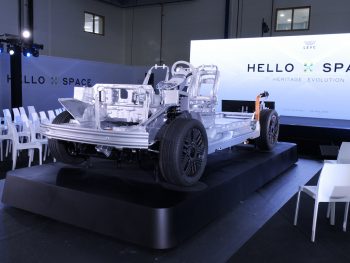LEVC to break into electric car space with new SOA platform
London Electric Vehicle Company (LEVC), most famous for making the TX taxi, is to launch a brand-new range of electric cars and vans, centred around a brand-new EV-focused platform.

The SOA modular and scalable platform is said to set new standards for onboard space and offers multiple seating and load-carrying configurations
The Coventry-based business, which is owned by Geely, said it was transforming “from a high-end taxi manufacturer to a leading provider of pure electric global mobility solutions”.
It already makes the range-extender VN5 van and TX taxi, and is now planning a new range of “state-of-the art” electric vehicles, under its vision of “a sustainable mobility future, for a better world”.
These will be built on the Space Oriented Architecture (SOA) EV platform, co-developed with Geely Holding Group over the past two and a half years at R&D centres in China, Sweden, the UK and Germany.
It’s a modular and scalable platform, said to set new standards for onboard space and offering multiple seating and load-carrying configurations. It’s also claimed to deliver significant advances in driving range, efficiency, safety, charging time, durability and connectivity.
SOA is engineered for larger vehicles, starting from 4,860mm and up to 5,995mm in length and 1,945mm-1,998mm in width, with wheelbases from 3,000mm-3,800mm. It’s also able to accommodate front-, rear- and all-wheel-drive layouts too. Four-row configurations are also possible and the platform provides a fully flexible seat arrangement, with a sliding track that runs from the front to the rear of the architecture.
This means it’s configurable for a diverse line-up of new products, from passenger-carrying models – such as SUVs and MPVs – to commercial vehicles.
It’s able to take battery packs ranging from 73kWh to 120kWh, delivering long ranges of up a claimed 432 miles (695km) and enabling ultra-fast charging. The battery is centrally located battery, providing a fully flat floor, whether for passenger or boot space, or both. It also features low step-in heights to enable multiple seating configurations.
Details are a bit thin on the ground of the first model to be based on SOA, but the brand says it will be a “completely new offering, launching LEVC into new sectors”.
LEVC also claims that the platform will set new standards for safety thanks to high-performance crash structure and energy absorption, achieving five-star safety standards in Europe and China.
The onboard experience will be further enhanced by a new electronic architecture, dubbed L-OS, and providing a complete digital operating system, from autonomous capability to intelligent cockpits. The technology means SOA-based vehicles will be capable of autonomous driving from Level 2 up to Level 4. Over-the-air updates will be available to enhance useability and efficiency without the need for dealer visits.
Geely already has its own EV-focused SEA architecture, underpinning models such as Smart’s new #3 and Polestar 4. Technical details of any overlaps between the two haven’t been announced and it’s not known whether SOA will be used for any other models within the group. However, LEVC said that it’s an open-source electric vehicle platform, available for partners outside of LEVC and Geely to use as the basis for their future product, reducing development costs.
Alex Nan, CEO of LEVC, commented: “Building on LEVC’s unrivalled heritage in producing the iconic London black cab, we are adapting our business to meet the rapidly accelerating demand for spacious, flexible electric vehicles. Our rich history is combined with the resources of the Geely organisation to set our brand on an exciting new path, as LEVC today launches an adaptable architecture for an adapting world. With the combined strength of our new strategy and SOA, we will bring advanced zero-emission transportation to more customers than ever before.”












